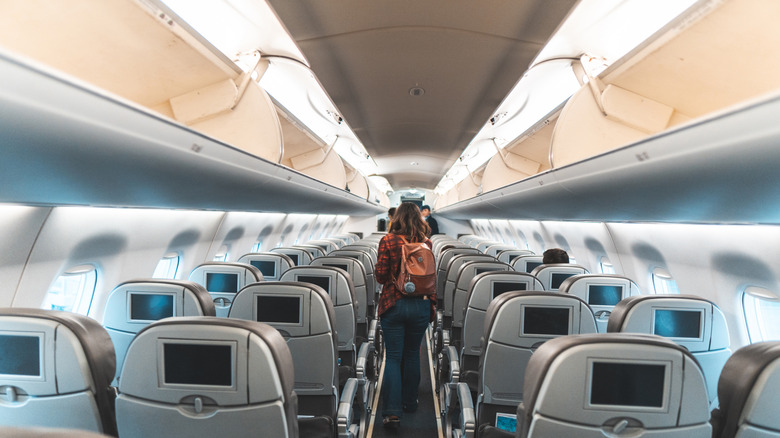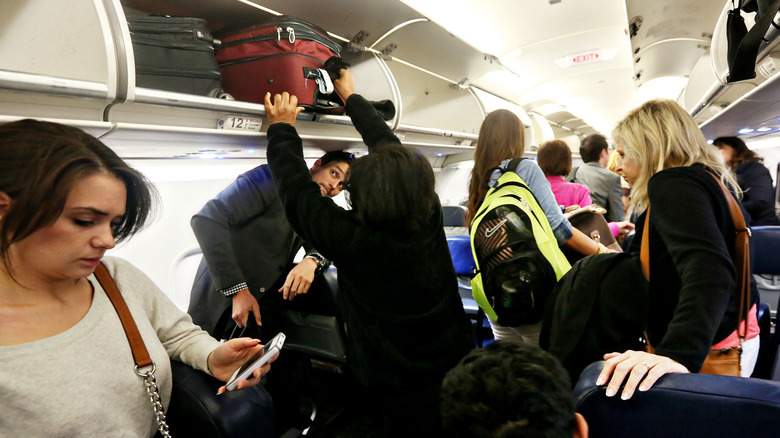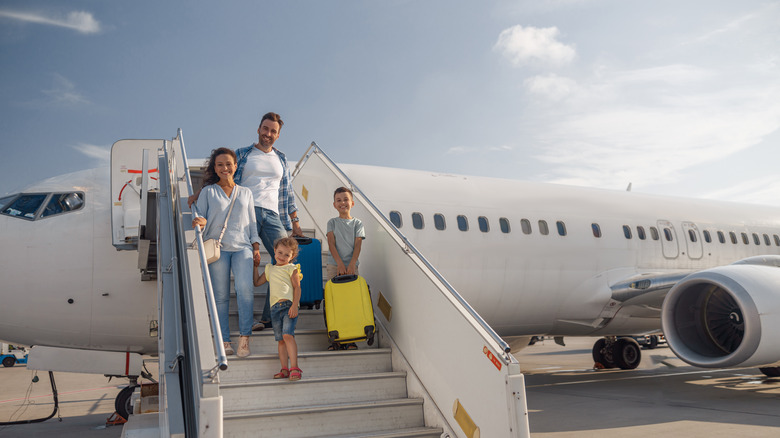Unspoken Etiquette Rules Of Deboarding A Plane, Per A Flight Attendant
When the airplane's tires so much as touch the ground, everyone starts to fidget and scurry; it begins. Once the seatbelt sign gets turned off — we've all been there — mayhem ensues. People jump up, start grabbing their bags from the overhead compartments, cutting the line, and any respect for personal space goes out the window. It's a fact: Deboarding a plane is a chaotic and stressful part of air travel. The rush to exit the aircraft often leads to frustration, impatience, and even conflict among passengers. However, according to Jacqueline Whitmore, an etiquette expert, former flight attendant, and author of "Business Class: Etiquette Essentials for Success at Work," there are some unspoken rules that, when followed, can make the deboarding process smoother and more pleasant for everyone.
First and foremost, Whitmore emphasizes that it's essential to follow the unwritten rule of deplaning row by row. "After the plane lands and the fasten seat belt sign goes off, passengers may start to deplane, one row at a time," she notes. However, she warns that "it's unsafe to stand until this happens." Simply put, wait your turn; it's basic etiquette, and patience is a virtue. Even once it's safe to stand, passengers should wait until the row in front of them has begun to deplane before they make a move. This orderly process helps avoid bottlenecks in the aisle and ensures that everyone can exit the plane as efficiently as possible. But, of course, there are always exceptions to the rule.
The etiquette of going ahead, priority deplaning, and helping others
According to Jacqueline Whitmore, in certain situations, it is acceptable to deplane before the people in the rows in front of you. For instance, if the passengers ahead are taking extra time to gather their belongings or are busy wrangling children, they may insist that you go ahead of them. In this case, it's perfectly fine to politely accept and move forward. Additionally, if you have an upcoming connecting flight, Whitmore suggests letting a flight attendant know as soon as possible, "They can make an announcement alerting the other passengers to allow those with tight connections to deplane first," she explains. This consideration can make a massive difference between catching your next flight on time versus being stranded in an unfamiliar airport.
Whitmore also highlights some behaviors — the unspoken airplane etiquette rules of which passengers may or may not be aware of — that would be considered rude during the deboarding process. For example, during deboarding, it's not uncommon to see someone struggling to get their bag out of the overhead bin. Whitmore explains that one of the rudest behaviors is failing to offer assistance when someone needs help. Another faux pas? "Being impatient with someone who is clearly struggling trying to get their children or aging parents out of their seat," she says. Traveling can be challenging, especially for those who are elderly, flying with young children or babies, or carrying heavy luggage — or all of the above, simultaneously. A little patience and kindness can go a long way.
Extra tips for airplane passengers
When deboarding, it's natural to want to stand and stretch your legs after being seated for an extended period — especially after a fatigue-inducing red eye or surviving a long-haul flight. However, Jacqueline Whitmore warns against blocking the aisle. "It's okay to stand in front of your seat when others are deboarding. Just don't block the aisle with your body or belongings," she explains. This allows other passengers to pass by easily and helps to keep the flow of traffic moving. You don't want to be that person causing a massive traffic jam on the aisle; try to be mindful of the space, objects, and people around you.
Ultimately, the most critical aspects of deboarding etiquette are patience and respect. Air travel is unpredictable, and sometimes, things don't go as smoothly as planned. Passengers may take longer than expected to gather their belongings, or there may be delays in disembarking. The key is to remain calm and patient, even during these less-than-pleasant times. Take a deep breath and remind yourself that everyone — just like you — is eager to get off that plane, but following simple etiquette rules, like the ones offered by Whitmore, can make the process more bearable for everyone. Deboarding a plane doesn't have to be a stressful experience.


